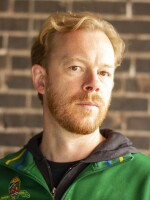In the halls of Lawrence Art Center, kids are bustling, building, socializing and rehearsing for a play. In the middle of the hall, artist Anthony Corraro opens the printmaking studio to share some of his materials for his works that are subject to change.
"This is some of the pulverized dust that I've colored with screen printing ink," he said.
Corraro holds up a jar of colored dust he is about to spread on to his first of four printing screens.
"I'm mixing it up because the dust needs to be different particle sizes," he said. "Some needs to be small enough to fit through the screen, but some needs to be large enough where it can agitate the screen. If it's too small, it'll just gum up in the screen. If it's too big, it won't go through."
Extensive experimentation led Corraro to this process in grad school, "I just lay out the screen."

Corraro has four screens that are the typical screen printing CMYK color scheme: cyan, magenta, yellow and key — key being black in most cases. Instead of using screen printing ink, Corraro uses colored dust to push onto a board. The screens have to be suspended slightly above the board to allow the dust to settle.
"All these images are bit mapped," he said.
A bitmap is like an old newspaper photo. Instead of fine dots that make up a whole image, a bitmap does this in pixels and each pixel is one of the four CMYK colors.
In this case, Corraro is using an image of transformation — a caterpillar to chrysalis to butterfly. He uses his own photographs from walks in nature, "So I'll go ahead and do the first one now here you."
An ill-aimed sneeze could destroy the work before it’s finished.
"It's very fragile work, but that's part of the idea," Corraro said. "Is that not only is it ephemeral, but it's very fleeting."
As with dust, even the slightest movements can disturb the work.
"If there is an air current that is slowly moving it over time, or if a bug crawls across it, or if someone comes in and pokes it. All these have happened," he said.
Four days into Corraro’s exhibit at the Lawrence Art Center, a four-year-old student found himself very present with one of Corraro’s temporary works.
"A kid just climbed on top of one of the pieces and just completely scattered it," Corraro said. "He was just in the moment."
This process is a bit of a spiritual practice that has its roots in early custodial work Corraro took on for employment.
"It was sweeping, mopping, scrubbing, dusting, all this kind of like menial labor, labor that I found to be very meditative."
And the material from that labor hooked him.
"I like dust as like a concept, because dust isn't really a single object, it's an amalgamation of everything within that environment. Calling back to Buddhist philosophy, the idea of like, many becoming one, one becoming many."

Corraro came to this process and frame of mind through hard work and discovery. He graduated from Oklahoma State University before an internship at Universal Limited Art Editions in New York.
"I had never even touched printmaking outside of high school," he said. "That's where I fell in love with printmaking."
From there, Corraro went to graduate school at Wichita State University, where he found himself in the print studio more and more frequently — experimenting with dust.
"It's an extensive process making sure, like, the earth is not only dyed, but I filter out all the pebbles, the little bits and bobs that can't fit through the screen."
After graduate school, Corraro started his current residence in Lawrence.
"I come here and I feel spoiled," he said. "I get access to a print shop, living situation ... [a] stipend, and I get [a] teaching experience. It's wonderful."
And this teaching experience will come in handy on his next foray of discovery at the Kansas City Art Institute.
"I’ll be going to KCAI to teach as part of their foundations program. And it'll be for just the fall semester."
Teaching should pay more than his current transient works of art.
"I'd like to be able to support myself as I continue my creative practice," he said. "It may come as a surprise to you, but I don't sell my work."

A previous version of this post featured mispellings of Anthony Corraro's last name.



